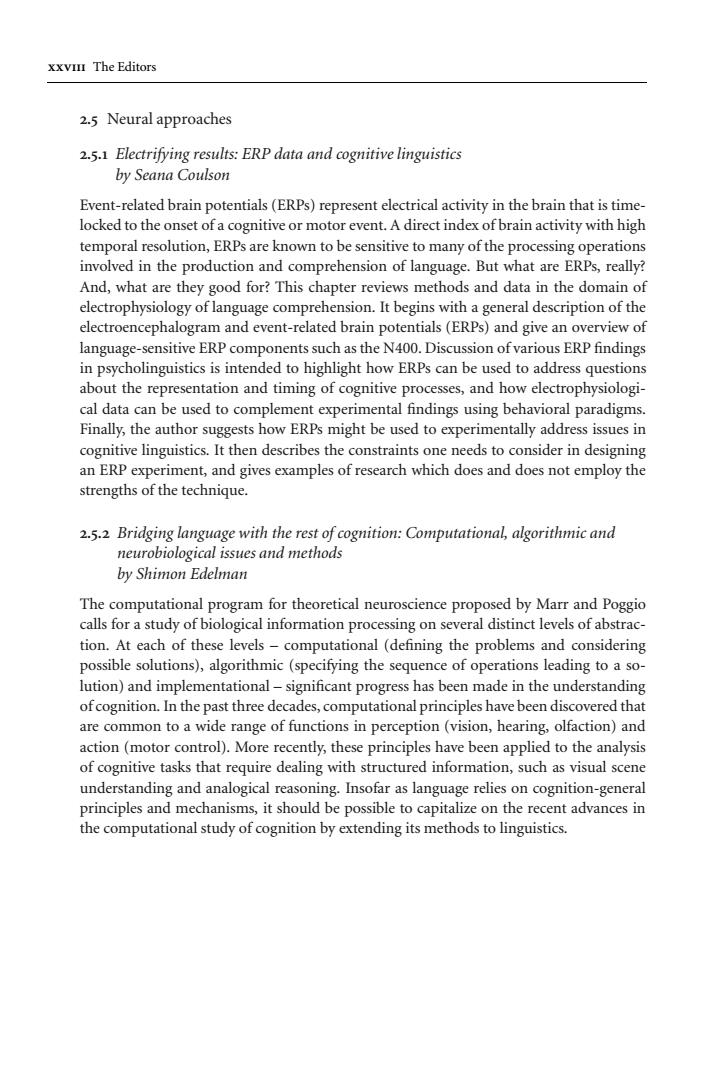正在加载图片...

xxvI The Editors 2.5 Neural approaches 2.5.1 Electrifying results:ERP data and cognitive linguistics by Seana Coulson Event-related brain potentials(ERPs)represent electrical activity in the brain that is time- locked to the onset of a cognitive or motor event.A direct index of brain activity with high temporal resolution,ERPs are known to be sensitive to many of the processing operations involved in the production and comprehension of language.But what are ERPs,really? And,what are they good for?This chapter reviews methods and data in the domain of electrophysiology of language comprehension.It begins with a general description of the electroencephalogram and event-related brain potentials(ERPs)and give an overview of language-sensitive ERP components such as the N400.Discussion of various ERP findings in psycholinguistics is intended to highlight how ERPs can be used to address questions about the representation and timing of cognitive processes,and how electrophysiologi- cal data can be used to complement experimental findings using behavioral paradigms. Finally,the author suggests how ERPs might be used to experimentally address issues in cognitive linguistics.It then describes the constraints one needs to consider in designing an ERP experiment,and gives examples of research which does and does not employ the strengths of the technique. 2.5.2 Bridging language with the rest of cognition:Computational,algorithmic and neurobiological issues and methods by Shimon Edelman The computational program for theoretical neuroscience proposed by Marr and Poggio calls for a study of biological information processing on several distinct levels of abstrac- tion.At each of these levels-computational(defining the problems and considering possible solutions),algorithmic(specifying the sequence of operations leading to a so- lution)and implementational-significant progress has been made in the understanding of cognition.In the past three decades,computational principles have been discovered that are common to a wide range of functions in perception (vision,hearing,olfaction)and action (motor control).More recently,these principles have been applied to the analysis of cognitive tasks that require dealing with structured information,such as visual scene understanding and analogical reasoning.Insofar as language relies on cognition-general principles and mechanisms,it should be possible to capitalize on the recent advances in the computational study of cognition by extending its methods to linguistics.JB[v.20020404] Prn:12/04/2007; 9:53 F: HCP18IN.tex / p.7 (445-471) The Editors . Neural approaches .. Electrifying results: ERP data and cognitive linguistics by Seana Coulson Event-related brain potentials (ERPs) represent electrical activity in the brain that is timelocked to the onset of a cognitive or motor event. A direct index of brain activity with high temporal resolution, ERPs are known to be sensitive to many of the processing operations involved in the production and comprehension of language. But what are ERPs, really? And, what are they good for? This chapter reviews methods and data in the domain of electrophysiology of language comprehension. It begins with a general description of the electroencephalogram and event-related brain potentials (ERPs) and give an overview of language-sensitive ERP components such as the N400. Discussion of various ERP findings in psycholinguistics is intended to highlight how ERPs can be used to address questions about the representation and timing of cognitive processes, and how electrophysiological data can be used to complement experimental findings using behavioral paradigms. Finally, the author suggests how ERPs might be used to experimentally address issues in cognitive linguistics. It then describes the constraints one needs to consider in designing an ERP experiment, and gives examples of research which does and does not employ the strengths of the technique. .. Bridging language with the rest of cognition: Computational, algorithmic and neurobiological issues and methods by Shimon Edelman The computational program for theoretical neuroscience proposed by Marr and Poggio calls for a study of biological information processing on several distinct levels of abstraction. At each of these levels – computational (defining the problems and considering possible solutions), algorithmic (specifying the sequence of operations leading to a solution) and implementational – significant progress has been made in the understanding of cognition. In the past three decades, computational principles have been discovered that are common to a wide range of functions in perception (vision, hearing, olfaction) and action (motor control). More recently, these principles have been applied to the analysis of cognitive tasks that require dealing with structured information, such as visual scene understanding and analogical reasoning. Insofar as language relies on cognition-general principles and mechanisms, it should be possible to capitalize on the recent advances in the computational study of cognition by extending its methods to linguistics